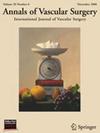Pediatric Versus Adult Blunt Cerebrovascular Injuries: Patients Characteristics, Management, and Outcomes
IF 1.4
4区 医学
Q3 PERIPHERAL VASCULAR DISEASE
引用次数: 0
Abstract
Background
Blunt cerebrovascular injury (BCVI) management in children currently follows guidelines developed for adults, with limited data on their efficacy in the pediatric population. This study aimed to explore injury features in the pediatric population with BCVIs and compare the clinical manifestations, diagnosis, and treatment of pediatric and adult BCVIs.
Methods
A retrospective data analysis of BCVI patients was conducted using the PROspective Observational Vascular Injury Treatment (PROOVIT) registry, covering the period from 2013 to 2022. The clinical manifestation, treatment, and outcome were compared between the adult and pediatric populations (<18 years old).
Results
This study included 38 pediatric and 1,310 adult patients with BCVIs. Pediatric patients had a higher median Abbreviated Injury Scale head score (4 vs. 3, P < 0.001) and a lower Glasgow Coma Scale at admission (9 vs. 14, P = 0.005). The 2 groups had no significant differences in Biffl grade injury distribution. Computed tomography angiography was the primary diagnostic method used in both groups (78.9% in pediatrics and 87.8% in adults; P = 0.084). Carotid artery injuries were the most frequently affected vessels in pediatric patients (71%), while vertebral artery injuries were more prevalent in adults (53.4%) (P < 0.001). Treatment methods were similar, with most patients receiving medical treatment (68.4% in pediatrics vs. 77.4% in adults; P = 0.264), although fewer pediatric patients continued medical therapy postdischarge (52.6% vs. 81.1%, P = 0.031). The incidence of BCVI-related stroke was similar between groups (7.9% in pediatrics vs. 6.3% in adults; P = 0.959). In-hospital mortality was not significantly different between the 2 cohorts, but hospital length of stay differed significantly, with pediatric patients having shorter stays than adults (P = 0.047).
Conclusions
Our findings suggest that the current management patterns for BCVI in children are not significantly different from those in adults. This similarity may reflect the adoption of care strategies based on adult experience in the absence of pediatric-specific guidelines. Additionally, the outcomes in the pediatric population were comparable to those observed in adults, underscoring the potential effectiveness of these adapted approaches while highlighting the need for further research to develop age-specific guidelines for pediatric BCVI management.
求助全文
约1分钟内获得全文
求助全文
来源期刊
CiteScore
3.00
自引率
13.30%
发文量
603
审稿时长
50 days
期刊介绍:
Annals of Vascular Surgery, published eight times a year, invites original manuscripts reporting clinical and experimental work in vascular surgery for peer review. Articles may be submitted for the following sections of the journal:
Clinical Research (reports of clinical series, new drug or medical device trials)
Basic Science Research (new investigations, experimental work)
Case Reports (reports on a limited series of patients)
General Reviews (scholarly review of the existing literature on a relevant topic)
Developments in Endovascular and Endoscopic Surgery
Selected Techniques (technical maneuvers)
Historical Notes (interesting vignettes from the early days of vascular surgery)
Editorials/Correspondence

 求助内容:
求助内容: 应助结果提醒方式:
应助结果提醒方式:


